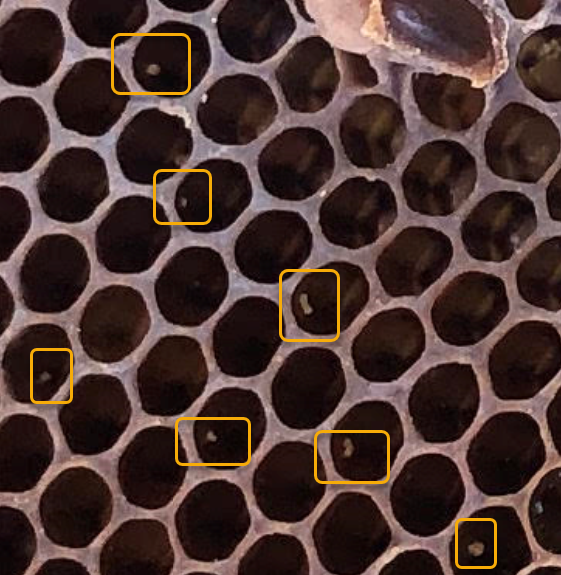From Debbie in Massachusetts: I have a hive on the south coast of Massachusetts. It was a very productive hive, producing over 40 pounds of honey this year. They went into the winter in good shape. I opened up the hive at Thanksgiving, and things looked good. Then I opened it up again to install ventilation just after Christmas, and found total disaster. Not a single bee alive. They had been treated for varroa mites. They had plenty of honey, so starvation wasn’t an issue. What happened??? This is so discouraging! Is it a virus? bacteria? How do you tell, and does it matter, since you can’t do much about it?
Dear Debbie,
You’re not alone.
Ray (also from Massachusetts) wrote: I’m asking for help, I have 2 hives now. I lost one to varroa mites, tested by a bee disease lab.
From Bob in Albany County, New York: I walked out to the hives to check on the one hive I was concerned about and found nothing but dead bees.
And I am sorry to report that I have had the same problem this year, as well. Last week I discovered six hives in my care in the Betterbee Apiary were dead. They’d been OK before Christmas, well-supplied with honey and treated in the summer and fall.
Of course, as soon as I examined them, I was pretty sure what had caused this: varroa mites and the viruses the mites brought into the hive. To make certain, I asked for a second opinion from one of the Betterbee partners, Chris Cripps DVM. We looked through the hives together and he confirmed it. These hives had still been flying during the last warm spell, but deaths this early in the season are most frequently caused by mites.
One of the clearest diagnostic signs is finding varroa mites on the bodies of the bees. A second sign is the presence of guanine, guanine is mite poop, left behind when the mites are reproducing under the cappings with the bee pupae. To check for guanine, hold a brood frame upside down and look for white specks on the upper surface of the cell. The picture you provided is shown below and the cells with the guanine specks are circled. We also looked at the other picture of the dead bees, and it appears there are some bees with mites still on their bodies.
These signs tell the story of a hive that was overwhelmed by mites, probably late in the season after it had already been treated. It is not a rare event, and often happens to strong, productive hives. Their strength is part of their downfall because they are strong enough to go out and rob other nearby hives which are crashing from mites and viral infections. And they bring the catastrophe back home. As their numbers dwindle from losses due to the viruses’ prematurely shortening the bees’ lives, eventually the hive simply cannot muster the critical mass to keep themselves warm. And then, the first sharply colder period finishes them off.
This is likely what happened to my hives here, too. As well as the hives of the several other readers who wrote to ask about the same thing.
While these hives didn’t have identical treatment histories, none of them had been just left to fend for itself. This was not so much a failure to treat for mites as much as a failure to achieve – and maintain – adequate mite control, particularly in the late summer through fall period.
It’s possible to have a treatment failure if the chemical doesn’t do the job, for one reason or another. It could be an operator error in applying it correctly; It could be an environmental factor that somehow inhibits the effectiveness of the chemical. It could be that the application wasn’t appropriately matched to the brood status in the hive.
But the most likely problem was a human factor. It’s natural to think that treatment itself is the goal. But it’s not, it’s only a means to the end, which is maintaining control of the mite population on an on-going basis throughout the season.
This is not to suggest that varroa treatment should be non-stop, month after month. That would likely be an overload. But it does mean that beekeepers must keep a permanent focus on the dynamics of the mite population and how it is continually changing. Mite control is not a once-and-you’re-done thing. Even doing more than one treatment (i.e, a summer one, a fall one and a pre-winter one) isn’t a guaranteed protection, though it certainly improves the odds.
Mite monitoring plays a critical role here, too, particularly for late-season surveillance. Both alcohol washes and sugar rolls become riskier as the season winds down in late September and October. Sticky board counts may be better for detecting post-treatment re-infestations.
The only bright spot in this disaster is that it is unlikely that you have a problem that will make your equipment unsafe to reuse for new bees in the spring.
Between now and then, think over your mite control strategy for 2020. Think about how you can add more monitoring, especially after mid-summer and whether additional treatment periods would keep the wretched mites from getting the upper hand, again. Losing a hive to mites is very upsetting, let that distress fuel your determination to have a different outcome next year. That’s my best advice, and I plan on taking it myself.
Nancy


